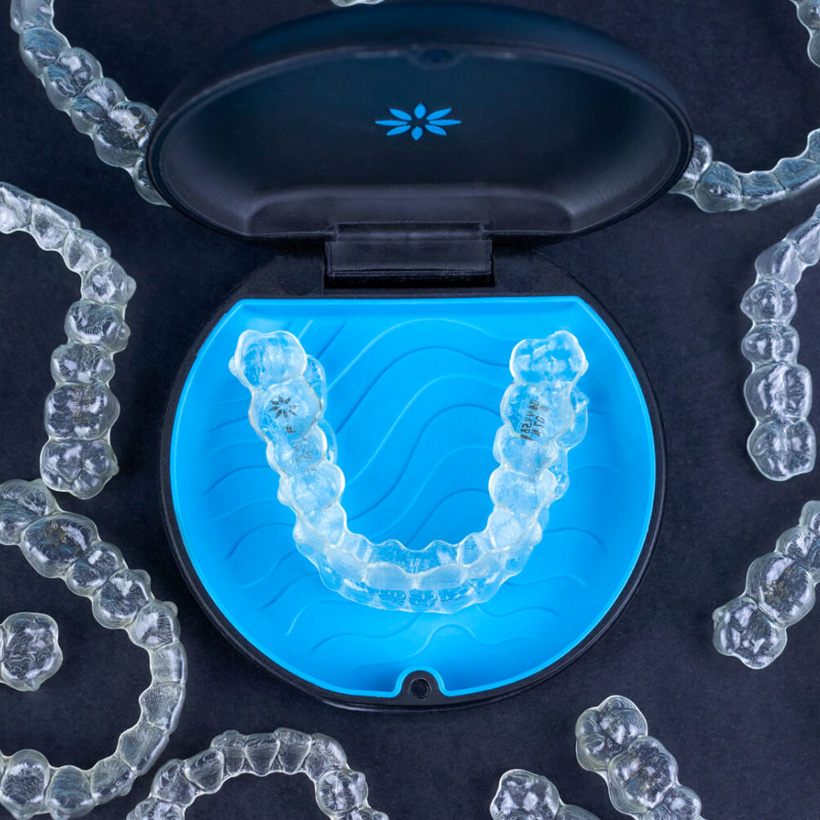
Get perfect smile with Invisalign at Burtonsville Dental Suite
Invisalign® is a popular alternative to traditional metal braces. Many patients favor them for their discreet, almost invisible appearance. For many patients, Invisalign can deliver results almost as quickly and as efficiently as traditional metal braces.
Invisalign is available at Burtonsville Dental Suite in Burtonsville and the surrounding area. We can help you achieve the smile of your dreams without a mouth full of metal. Call us today at (301) 421-1300 to schedule an appointment and learn more.
The Research on Invisalign
Invisalign is the world’s most popular and advanced clear aligner system. With over twenty years of innovation on its side , it has delivered smiles to over nine million people and over 2.3 million teens. Each patient receives a set of custom-made aligners. The system includes proprietary virtual modeling software, rapid manufacturing processes, and mass customization, and the aligners consist of a patented material.
To achieve the best results, patients must wear their aligners for 20 to 22 hours per day, removing them only when necessary. Such instances include eating or drinking anything other than cool water. Patients must also keep regular visits to both the dentist and the orthodontist. The dentist can ensure the mouth is in optimal health, reducing the risk of Invisalign irritating any conditions. The orthodontist can ensure the treatment’s overall success while also switching out the patient’s aligners.
“With over twenty years of innovation on its side, it has delivered smiles to over nine million people and over 2.3 million teens.”
Who Uses Invisalign
While orthodontic treatment is commonly associated with youth, Invisalign is appropriate for both teenagers and adults. The primary difference between Invisalign for teens and Invisalign for adults is a little dot that changes color based on how often the patient wears their aligners. This keeps younger patients accountable for their treatment. Invisalign Teen aligners tray are blue, then turn clear or white throughout their lifetime. The bluer the circle is, the longer the patient must prolong their treatment.
Invisalign for adults is like Invisalign for teens — just without the color-changing circle. Both systems use aligner trays consisting of SmartTrack® material, a patented blend of plastic made exclusively for the Invisalign brand. Invisalign appeals to both teens and adults because their virtually invisible nature makes for a less awkward-looking orthodontic treatment.
“While orthodontic treatment is commonly associated with youth, Invisalign is appropriate for both teenagers and adults.”
What to Know About Invisalign
As mentioned above, many teenagers and adults are good candidates for Invisalign. However, as metal braces tend to deliver more precise results, Invisalign is best for patients with mild or moderately crowded teeth. Patients with minor teeth spacing issues may also benefit from clear aligners. Anyone who wants to start Invisalign treatment must also first address any gum disease or other dental disease, making dental appointments essential.
Furthermore, patients with more complicated issues with crowding or spacing (such as severe underbites, overbites, or crossbites) may require more intensive treatment. Invisalign is also typically unsuitable for children, as their mouths are usually still developing. Their teeth are still growing and changing, making them too unpredictable for clear aligners.
“…Invisalign is best for patients with mild or moderately crowded teeth.”
Invisalign vs. Traditional Braces
There are a few differences between Invisalign and traditional braces . The most obvious is aesthetics. When used appropriately, Invisalign is almost entirely inconspicuous — making it perfect for more self-conscious patients. Aligners are also removable, making them more convenient for eating and upkeeping oral hygiene.
Metal braces consist of two main components: brackets and wires. These place consistent, gentle pressure on the teeth to shift them gradually. Brackets are attached to the teeth, meaning they cannot be removed. As a result, many patients find them less comfortable than Invisalign, and it is typically more challenging to maintain oral hygiene. Patients will also need to avoid hard, crunchy, chewy, or sticky foods to prevent breaking the brackets or having them get stuck between the braces.
“When used appropriately, Invisalign is almost entirely inconspicuous — making it perfect for more self-conscious patients.”
Invisalign & Lifestyle Changes
One of the many advantages of Invisalign is that it requires minimal lifestyle changes. Patients will have to switch out their aligners every one or two weeks, and they will need to come into the office to pick up their new set of aligners every six to eight weeks. In most cases, Invisalign patients require fewer orthodontist visits than braces patients.
Still, there are some things patients should know to complete Invisalign treatment safely. They must care for them properly to avoid staining or other undesirable results. This involves rinsing the aligners nightly, brushing them gently with a soft-bristled toothbrush to keep them clean. If possible, patients should rinse them whenever they take them out. As mentioned earlier, patients should only remove aligners when necessary — such as when eating, brushing, or drinking anything other than cool water. Patients who play high-contact sports should ask Burtonsville Dental Suite if it is safe to keep the aligners in the mouth while playing.

